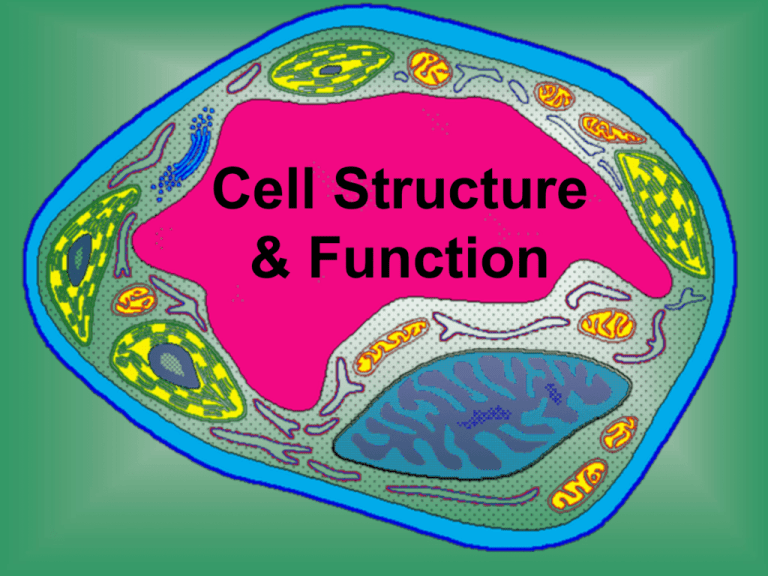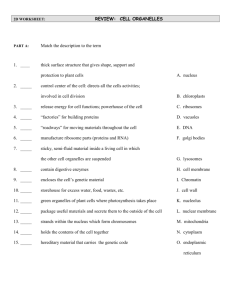Cell Structure & Function
advertisement

Cell Structure & Function Cell Theory • All living things are made up of cells. • Cells are the smallest working units of all living things. • All cells come from preexisting cells through cell division. Definition of Cell A cell is the smallest unit that is capable of performing life functions. Examples of Cells Amoeba Proteus Plant Stem Bacteria Red Blood Cell Nerve Cell Two Types of Cells •Prokaryotic •Eukaryotic Prokaryotic • Do not have structures surrounded by membranes • Few internal structures • One-celled organisms, Bacteria Eukaryotic • Contain organelles surrounded by membranes • Most living organisms Plant Animal “Typical” Animal Cell “Typical” Plant Cell Cell Parts Organelles Surrounding the Cell Cell Membrane • Outer membrane of cell that controls movement in and out of the cell • Double layer Cell Wall • Most commonly found in plant cells & bacteria • Supports & protects cells Inside the Cell Nucleus • Directs cell activities • Separated from cytoplasm by nuclear membrane • Contains genetic material - DNA Nuclear Membrane • Surrounds nucleus • Made of two layers • Openings allow material to enter and leave nucleus Chromosomes • In nucleus • Made of DNA • Contain instructions for traits & characteristics Nucleolus • Inside nucleus • Contains RNA to build proteins Cytoplasm • Gel-like mixture • Surrounded by cell membrane • Contains hereditary material Endoplasmic Reticulum • Moves materials around in cell • Smooth type: lacks ribosomes • Rough type (pictured): ribosomes embedded in surface Ribosomes • Each cell contains thousands • Make proteins • Found on ribosomes & floating throughout the cell Mitochondria • Produces energy through chemical reactions – breaking down fats & carbohydrates • Controls level of water and other materials in cell • Recycles and decomposes proteins, fats, and carbohydrates Golgi Bodies • Protein 'packaging plant' • Move materials within the cell • Move materials out of the cell Lysosome • Digestive 'plant' for proteins, fats, and carbohydrates • Transports undigested material to cell membrane for removal • Cell breaks down if lysosome explodes Vacuoles • Membrane-bound sacs for storage, digestion, and waste removal • Contains water solution • Help plants maintain shape Chloroplast • Usually found in plant cells • Contains green chlorophyll • Where photosynthesis takes place Cell Vocabulary • Cell membrane: separates a cell from its environment and protects the cell controlling entry into and out of cell • Cell wall: rigid; supports and shapes the plant cell • Chloroplasts: food for plant cells is made here • Cytoplasm: jellylike substance within the cell • Endoplasmic reticulum: network of passageways that carries materials from one part of the cell to another. Cell Vocabulary Cont. • Mitochondria: “powerhouse” of cell • Nucleus: acts as the “brain” of the cell. You can think of the nucleus as the cell’s control center. It holds the genetic material, which contains the instructions for the cell’s functions • Ribosomes: where proteins are made • Vacuole: stores water, food, and other materials that a cell needs Summary • During this presentation we learned about some of the basic differences between animal and plant cells. • Cells have common organelles, but each cell has different organelles depending on what it does. Review Questions 1. What is the function of the cell membrane? 2. Why is the nucleus sometimes called the control center of the cell? 3. Name two plant cell parts that are not found in animal cells. What is the function of each part? 4. Compare the functions of the cell wall in a plant cell and the cell membrane in an animal cell. How are the functions of the two structures similar and different?









